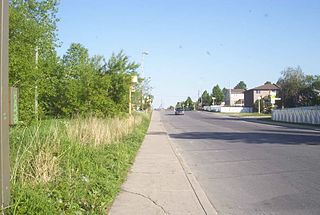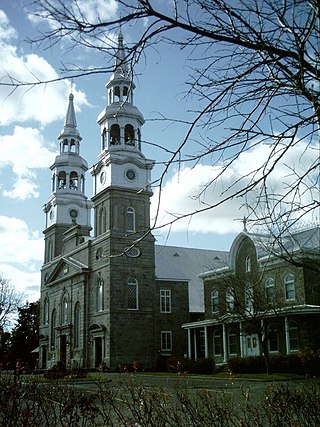
The urban agglomeration of Montreal is an urban agglomeration in Quebec, Canada. Coextensive with the administrative region of Montreal, it is a territory equivalent to a regional county municipality (TE) and a census division (CD), for both of which its geographical code is 66. Prior to the merger of the municipalities in Region 06 in 2002, the administrative region was co-extensive with the Montreal Urban Community.

The Orange Line, also known as Line 2, is the longest and first-planned of the four subway lines of the Montreal Metro in Montreal, Quebec, Canada. It formed part of the initial network, and was extended from 1980 to 1986. On April 28, 2007, three new stations in Laval opened making it the second line to leave Montreal Island.

De La Savane station is a Montreal Metro station in the borough of Côte-des-Neiges–Notre-Dame-de-Grâce in Montreal, Quebec, Canada. It is operated by the Société de transport de Montréal (STM) and serves the Orange Line. It is located in the Côte-des-Neiges area on the border of the town of Mount Royal. It opened on January 9, 1984.
Maisonneuve was a federal electoral district in Quebec, Canada, that was represented in the House of Commons of Canada from 1896 to 1935.

Montreal East is an on-island suburb in southwestern Quebec, Canada, on the island of Montreal. Montreal-Est has been home to many large oil refineries since 1915.

Anjou is a borough (arrondissement) of the Canadian city of Montreal. Prior to its 2002 merger it was an independent city. Although it is no longer an independent city, it is still commonly known as known as Ville d'Anjou. Anjou has a predominantly Francophone population.

Montreal North is a borough within the city of Montreal, Canada. It consists entirely of the former city of Montreal North on the Island of Montreal in southwestern Quebec. It was amalgamated into the City of Montreal on January 1, 2002.

Rivière-des-Prairies–Pointe-aux-Trembles is a suburban borough (arrondissement) on the eastern tip of the city of Montreal, Quebec, Canada. It is located at the eastern end of the Island of Montreal.

Mascouche is a commuter railway line in Greater Montreal, Quebec, Canada. It is operated by Exo, the organization that operates public transport services across this region.

The Montreal Metro is a rubber-tired underground rapid transit system serving Greater Montreal, Quebec, Canada. The metro, operated by the Société de transport de Montréal (STM), was inaugurated on October 14, 1966, during the tenure of Mayor Jean Drapeau.

The Red Line, also known as Line 3, was a proposed line of the Montreal Metro.

The White Line, also known as Line 7, was a proposed line of the Montreal Metro that never made it past its planning stage.

Gouin Boulevard is the longest street on the Island of Montreal, stretching 57.6 kilometres (35.8 mi) across the north side of the island from Senneville in the west to Pointe-aux-Trembles in the east, where it intersects with Sherbrooke Street.

The Le Gardeur Bridge is a beam bridge that connects the east end of the island of Montreal, in Pointe-aux-Trembles, to Repentigny.
Montreal has a developed transport infrastructure network, which includes well-developed air, road, rail, and maritime links to the rest of Canada, as well as the United States and the rest of the world. Local public transport includes a metro system, buses, ferry services and cycling infrastructure.
The Centre de services scolaire de la Pointe-de-l'Île (CSSPÎ) is an autonomous school service centre in Montreal, Quebec, Canada, based primarily in the city's east end, appointed by the Ministry of Education.

Pointe-aux-Prairies Nature Park is a large nature park in the Rivière-des-Prairies–Pointe-aux-Trembles borough of Montreal, Quebec, Canada.

Côte-Vertu Boulevard is a boulevard in the Saint-Laurent borough in Montreal, Quebec. It crosses the borough from north-east to south-west of the Air Canada Technical Center to the west of the Chomedey Highway Autoroute 13 to the Laurentian Autoroute 15 where it takes the name of Sauvé Street. The section inside the city of Dorval has remained under the name Côte-Vertu Road.















